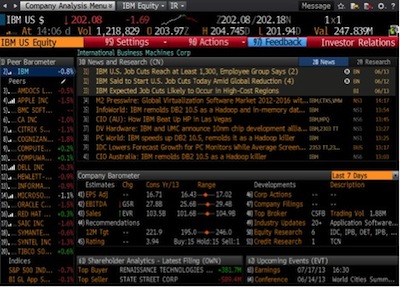Some new tools, some old ones, made slick and easy for IROs
IROs who use ‘a Bloomberg’, the ubiquitous data terminal used by finance professionals and many corporate finance executives, usually have to walk to the treasurer or CFO’s office to find one. Now Bloomberg hopes they’ll want terminals on their own desks after launching a new set of tools tailored for investor relations.
Bloomberg calls it an Investor Relations Dashboard and it is accessed – appropriately enough – by typing IR<GO> on the Bloomberg Professional service.
Among the features shown off at Bloomberg’s New York headquarters last week were a peer barometer showing who’s stock is up or down and a company barometer with estimate changes and other updates.
Drilling down into any company name or metric seems to open up a whole new level of data, whether it’s the volume and sentiment of news flow for peers, or which broker is handling the most volume in different stocks. Plus, it’s all accessible on mobile devices.
Pressure changes
The word ‘barometer’ was carefully chosen. ‘We’re really trying to capture the concept of pressure,’ says Drew Jones, Bloomberg’s business manager for corporations, investment banking and private equity. ‘Whether it’s changes in estimates, changes in ratings, or new research reports, IROs need to know what’s in the news about them and their peers.’
To design the IR dashboard, Jones and his team talked to IROs about their work flow, asking what they do and how they do it. ‘The data differs by region but the job is consistent globally,’ Jones says they found.
About three quarters of Bloomberg’s existing IRO users have had a chance to beta test the IR dashboard over the last few months. Their feedback has led to final tweaks, such as a credit tab in the peer barometer.
While the barometer analytics are new, other sections of the IR dashboard have familiar Bloomberg content such as analyst estimates or research from Bloomberg Industries, which launched last year with a team of industry analysts, many of them former sell-siders.
Some features, such as new shareholder analytics showing which institutions are buyers or sellers in a company’s own stock and its peer stocks, have clearly been designed as targeting tools. But Bloomberg’s IR dashboard stops short of trying to be a dedicated targeting and CRM system, like Thomson One or Ipreo’s BD Corporate. There’s no event or meeting management involved, and no information distribution.
However, IROs who haven’t been distracted by Bloomberg’s recent privacy problems could make good use of its hugely popular instant messaging and email functions, which directly link together its 315,000 users. For example, an IRO can look up any user and see if he or she is available to chat. ‘The IRO is one node in that ecosystem,’ Jones says. ‘Messaging is part of the community benefit.’
With its own industry research, consensus estimates and share ownership information, not to mention a huge range of sources for external data, Bloomberg has long been a gold mine for IROs – but one that was hard to make full use of. The new IR dashboard makes a dizzying array of data much more easily accessible. 
Bloomberg's new IR dashboard combines new tools like a peer barometer (left) with familiar ones like news and research.










